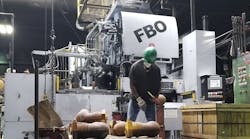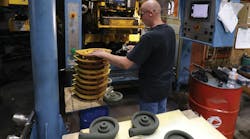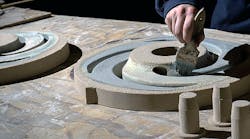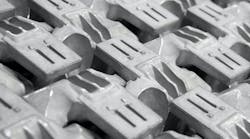A research scientist, working on a speculative consulting basis, has developed a gas-curing technology he expects will benefit foundries that use sand binders to form molds and cores. “Amine-cured, ester-cured, (and) acid-cured chemistries all generate significant amounts of waste from their inherently poor gas utilization,” explains Steve Smith.
Without detailing his discovery, Smith describes his patent-pending technology as something that "can be implemented by any gas-curing foundry without any capital equipment expense," said Smith. "That’s the big surprise, how affordable it is to start saving money."
Smith indicates that he expects to license the technology to metalcasters, rather than pursue a more traditional commercial roll-out.
“The capture, neutralization, and waste disposal costs add to the excessive raw-material costs to reduce foundry profit margins," he adds. "Greater chemical usage contributes to greater employee chemical exposure, and presents a continuing challenge to keep worker exposure within safe limits and minimize health-related costs."
In comments to FM&T, Smith detailed how he responded to a proposal by an unnamed company seeking an improved foundry-sand binding system, though the client did not indicate what aspect of existing processes it wanted resolved. "It struck me that the extraordinarily low gas-utilization efficiencies and attendant waste streams were a very illogical thing, since there was such an obvious solution to it," Smith recalls.
Smith filed a provisional patent on his development, but the still-unnamed client declined to option the technology. "After quite some delay, and exploratory work with a microwave-transparent foundry shell binder system that was easily machinable," and which he also developed, "they suddenly got very busy with other things, and went away," he continues.
If Smith's gas-curing technology is commercially successful, it may offer foundries a method of reducing their need for esters and amines, and he predicts they will find it to be an effective way to reduce consumable costs and waste streams.
Smith — who can be contacted by email or through his website — holds a master’s degree in physics and long experience in the business of aerospace electronics. For two decades he studied the design of radar transmitters and their magnetic components (e.g., transformers, inductors, saturable reactors.) He holds 11 patents in the field of electronics, and he's the author of Magnetic Components: Design and Applications, a book about transformer design. Smith also formulated a line of adhesive products, primers, impregnating sealants, and coatings.
Latest from Molds/Cores
Latest from Molds/Cores
Melt/Pour
Automated Pouring Takes on the Challenge
March 1, 2024
Issues and Ideas
Progress in e-Mobility Manufacturing
Feb. 29, 2024
Molds/Cores
New Molding Machine Fits Right In
Feb. 27, 2024
Molds/Cores
The Next Step in Horizontal Molding
Feb. 2, 2024
Molds/Cores
Change Is Now Non-Negotiable
Feb. 2, 2024
Molds/Cores
Foundry Starts 3D Printing Expansion
Jan. 4, 2024
Issues and Ideas
Cascade Die Casting Expanding
Nov. 28, 2023








